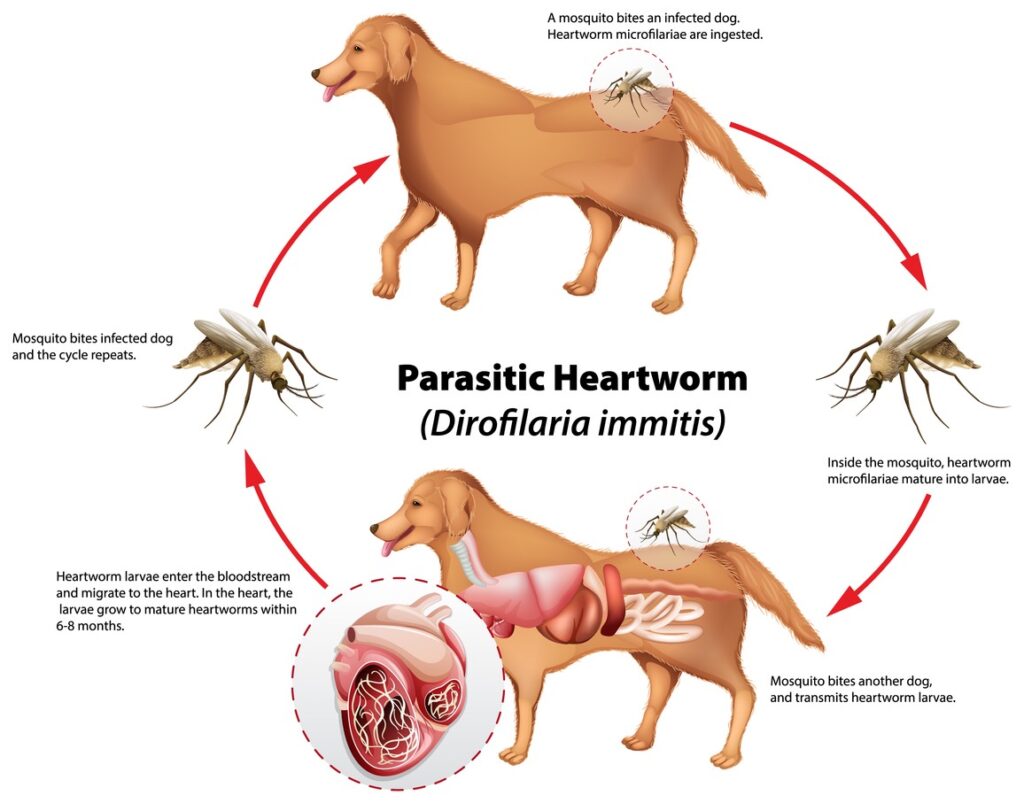Nestled amidst the picturesque landscapes of northeastern Nevada, Spring Creek may not experience the same prevalence of heartworm cases as some other states, but that doesn’t diminish the significance of proactive prevention measures. The threat of heartworm disease remains, making it crucial for pet owners in this serene community to prioritize preventive care for their beloved furry companions. Join us as we cover the risks heartworm disease poses to pets, and why prevention is paramount, even in areas with seemingly lower incidence rates.
What is Heartworm Disease?
Heartworm disease is a sickness that affects pets, especially dogs and sometimes cats. It’s caused by worms that mosquitoes carry. When an infected mosquito bites a pet, it passes the worms into the pet’s bloodstream. These worms then grow inside the pet’s heart and lungs, causing serious health problems.
The life cycle of a heartworm involves five stages:

- Mosquito Infection: It starts when a female mosquito bites an infected animal (usually a dog or a wild animal like a coyote or fox) carrying microscopic baby heartworms, called microfilariae, in its blood.
- Development of Heartworms in the Mosquito: Inside the mosquito, these baby heartworms mature into larvae over a period of about 10 to 14 days.
- Transmission: When the infected mosquito bites another animal, it injects these larvae into the animal’s bloodstream.
- Migration to Heart and Lungs: The larvae travel through the infected animal’s bloodstream until they reach the heart and lungs. There, they grow into adult worms over several months. The worms can grow up to a foot long and take residence in the heart and lungs of dogs or cats.
- Mating and Production of Microfilariae: Once matured, the adult worms mate and produce microfilariae, which circulate in the infected animal’s bloodstream, completing the cycle.
Common Misconceptions About Heartworm Disease
There are misconceptions surrounding heartworm disease that can lead to complacency that puts pets at risk.
- One common misconception is that indoor pets are not susceptible to heartworm infection. However, mosquitoes can still find their way indoors, and all it takes is one bite to transmit the disease.
- Another misconception is that heartworm disease only affects dogs. While dogs are more commonly affected, cats and ferrets can also contract heartworm disease, and the consequences can be just as severe.
Symptoms and Signs of Heartworm Disease in Pets
The symptoms of heartworm disease can vary depending on the infection’s severity and the animal’s species. In the early stages, pets may exhibit subtle signs such as a mild cough or fatigue. This disease is often referred to as the “silent killer” because in its early stages, it often shows no symptoms or only very subtle ones. Dogs and cats infected with heartworms may not exhibit any signs until the disease has progressed to a more advanced stage. By this time, significant damage may have already occurred to the heart, lungs, and other organs.
Below are the symptoms listed by the American Heartworm Society for dogs and cats.
Dogs:
- Mild, persistent coughing
- Reluctance to exercise
- Fatigue after moderate activity
- Decreased appetite
- Weight loss
As heartworm disease progresses, a dog may develop heart failure and the appearance of a swollen belly due to excess fluid in the abdomen.
Cats:
Signs of heartworm disease in cats can be very subtle or very dramatic. Symptoms may include:
- Coughing
- Asthma-like attacks
- Periodic vomiting
- Lack of appetite or weight loss.
- Occasionally, an affected cat may have difficulty walking, experience fainting or seizures, or suffer from fluid accumulation in the abdomen.
Unfortunately, the first sign in some cases is the sudden collapse or death of the cat.
Diagnosis and Testing for Heartworm Disease
Early detection of heartworm disease is crucial for successful treatment and prevention of further complications. We typically perform a series of tests to diagnose heartworm disease, including a blood test that detects the presence of adult heartworms or their offspring. Imaging techniques like X-rays or ultrasounds can tell us the extent of the infection.
Like dogs, cats can be infected with heartworms. There are differences, however, in the nature of the disease and how it is diagnosed and managed.
While infected dogs may have 30 or more worms in their heart and lungs, cats usually have 6 or fewer—and may have just one or two. But while the severity of heartworm disease in dogs is related to the number of worm, in cats, just one or two worms can make a cat very ill. Diagnosis for cats can be complicated, requiring a physical exam, an X-ray, a complete blood count and several kinds of blood test. An ultrasound may also be performed.
Treatment Options
Treating heartworm disease in dogs can be complex and lengthy, especially in advanced cases. The goal of treatment is to eliminate adult worms and prevent further damage to the heart and lungs. Treatment typically involves a combination of medication, rest, and close monitoring by one of our veterinarians. In severe cases, surgery may be necessary to remove the worms from the heart and blood vessels.
Unfortunately, there is no approved drug therapy for heartworm infection in cats. The drug used to treat infections in dogs is not safe for cats. Because a cat is not an ideal host for heartworms, some infections resolve on their own, although these infections can leave cats with respiratory system damage In any case, cats with heartworm disease can often be helped with good veterinary care. The goal is to stabilize your cat and determine a long-term management plan.
Heartworm in Nevada
The AHS conducts a heartworm incidence survey every three years, working with veterinary practices and shelters that submit data from heartworm antigen tests run over the course of the previous year. The latest survey was conducted in early 2023 and reflects data from testing conducted during 2022.
Prevention and Proactive Measures Against Heartworm Disease
Prevention is a must when it comes to heartworm disease in dogs and cats. Several options for preventing heartworm infection are available, including monthly preventive medication and yearly testing. Our veterinarians can recommend the most suitable preventive measures based on your pet’s lifestyle, risk factors, and overall health. It is essential to consistently follow the prescribed preventive regimen to ensure your pet’s protection.
Defend Your Pet Against Heartworm Disease
In conclusion, while Spring Creek, Nevada, may not have the same high prevalence of heartworm cases as some other regions, the importance of proactive prevention cannot be overstated. Remember, just one mosquito bite can infect a pet! And it is heartbreaking to see pets suffer from heartworm disease when it can be prevented.
Early detection through regular veterinary check-ups and adherence to preventive measures are key to safeguarding the health and happiness of your furry companions. By remaining vigilant and committed to their well-being, you ensure that your pets continue to thrive free from the threat of heartworm disease. Contact us today.
Your Caring Team

